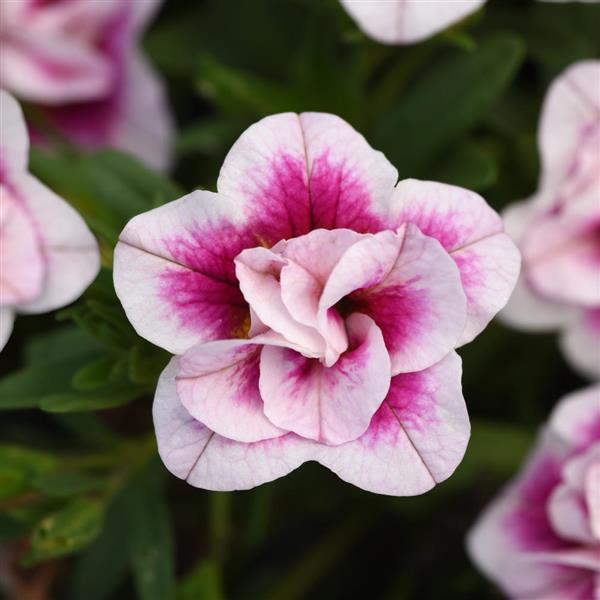Calibrachoa, Double PinkTastic
Price range: $7.99 through $8.99
Plant
Discount per quantity
| Quantity | 3 - 8 | 9 - 14 | 15+ |
|---|---|---|---|
| Price | Price range: $7.75 through $8.72 | Price range: $7.51 through $8.45 | Price range: $7.19 through $8.09 |
| % Discount | 3% | 6% | 10% |
Description
Double PinkTastic Calibrachoa: Your Cheerful Cascade of Color
Calibrachoa ‘Double PinkTastic’ is more than a pretty face. It is a lively partner in hanging baskets, a crowd-pleaser in patio planters, and a steady friend for gardeners who crave generous blooms with very little fuss. In this deep-dive, we will explore every bright petal and every hidden root of this charming plant. Together, we will learn how to invite its energy into our gardens and keep it thriving from the first bud of spring to the last glow of fall.
A Quick Welcome
We love flowers that make us smile the moment we see them. Double PinkTastic answers that call with layers of rose-pink petals kissed by soft white edges. Each bloom looks like a tiny rosette, and hundreds can cover one plant at peak season. In other words, you get a living bouquet that renews itself day after day. But most of all, you get color even when summer heat tries to slow other flowers down.
What Makes ‘Double PinkTastic’ So Special?
- Double Blooms, Double Joy
Unlike single-petaled calibrachoas, Double PinkTastic stacks its petals in neat layers. This full shape adds texture and a lush look that feels almost like a miniature rose. - Self-Cleaning Habit
Old flowers drop on their own. You don’t need to pinch spent blooms to keep new ones coming. Less work, more wow. - Vigorous Yet Compact
Heights stay around 8–12 inches, while trailing stems can spill 18–24 inches. That means a dense mound up top and graceful drapes below. Perfect for mixed baskets, window boxes, or as a soft edging in raised beds. - Long, Long Season
When nights warm into the 50s °F (about 10 °C), flowering starts. It continues until frost arrives. With steady food and water, you may count blooms past the 1,000 mark on a single plant. - Pollinator Perks
The trumpet shape invites hummingbirds and gentle native bees. Add two or three plants, and your patio turns into a friendly pollinator café.
Description
Flower Form and Color
Double PinkTastic wears a main coat of bright strawberry pink. The outer margin of each petal glows white, creating a two-tone ring that highlights the flower’s layered center. Some petals show fine raspberry stripes that radiate toward the rim, adding depth. Because each bloom is only about an inch wide, the color pattern looks like delicate candy swirls when viewed up close. Stand back a few feet, and the plant reads as a vibrant pink cloud.
Foliage and Growth Habit
Leaves are small, narrow, and slightly sticky to the touch—a handy trait that helps trap tiny pests before they cause trouble. Foliage stays fresh green all season, resisting the mid-summer yellowing some other varieties show. Stems branch freely from the base, filling potholes in containers and keeping the plant tidy.
Size at Maturity
- Height: 8 – 12 inches
- Spread: 18 – 24 inches
- Growth Speed: Fast once roots settle (about two weeks after planting)
Preferred Environment
This plant shines in full sun (six or more hours) but tolerates light afternoon shade, especially in hot regions. It loves temperatures between 55 °F and 85 °F (13 – 29 °C). Cooler nights trigger heavier flower sets, while high heat slows bloom for short spells before it rebounds.
Garden Uses
- Hanging Baskets – Let stems fall like pink confetti over the rim. Add trailing chartreuse sweet potato vine for a playful color pop.
- Window Boxes – Mix with upright Angelonia or dwarf fountain grass for height in the center, then let Double PinkTastic spill over the front.
- Patio Pots – Plant three around the edge of a 12-inch pot featuring a dwarf hibiscus in the middle. The hibiscus provides a tropical accent while calibrachoa covers the soil.
- Landscape Borders – Tuck along walkway edges where irrigation is reliable. The compact height stays neat alongside stone paths.
- Table Centerpieces – One small basket can live on an outdoor dining table, bringing color straight to eye level.
How to Care for Double PinkTastic
1. Planting Basics
| Step | Guidance | Why It Matters |
|---|---|---|
| Choose a Container | Minimum 10 in. wide with drainage holes | Allows root spread and prevents soggy soil |
| Potting Mix | Use a lightweight, peat- or coir-based mix with perlite | Ensures air around roots and quick drainage |
| Outdoor Soil | Raised beds or borders with organic matter and pH 5.5 – 6.2 | Matches the slightly acidic preference of calibrachoa |
Tip: If your garden soil is heavy clay, grow in containers. Roots of calibrachoa hate wet feet.
2. Light Needs
Full sun equals more flowers. Aim for at least six hours of direct light. In very hot climates, provide dappled shade in late afternoon. Instead of drooping, the plant will stay perky and bloom more evenly.
3. Watering Wisdom
- Frequency: Water when the top inch of mix feels dry. On hot, windy days that may mean daily watering for baskets.
- Method: Water deeply until you see it flow from the drainage holes. Let excess drip away.
- Signs of Trouble:
- Wilting with dry soil → Water sooner and mulch the surface with fine bark.
- Wilting with wet soil → The roots are drowning. Improve drainage and cut back on watering schedule.
In other words, moist but not soaked is the sweet spot.
4. Feeding for Endless Blooms
Calibrachoa is a heavy eater. Use a two-step plan:
- Slow-Release Fertilizer at Planting – Mix a balanced 14-14-14 (or similar) granule into the soil.
- Weekly Liquid Feed – Once buds show, water with a blossom-boosting fertilizer at half strength (for example, 15-30-15).
After more than a month of growth, you will notice leaves staying lush green. That is the first sign your feeding routine works.
5. Temperature and Humidity
- Ideal Range: 55 °F to 85 °F (13 – 29 °C)
- Heat Tolerance: Good. Short bloom pause above 90 °F (32 °C), then flowering resumes when temps dip.
- Cold Tolerance: Light frost stops growth and may blacken foliage. Protect with a lightweight frost cloth if a late spring cold snap threatens.
- Humidity Needs: Average garden humidity is fine. In very humid climates, space plants for good air flow to prevent mildew.
6. Pruning and Grooming
Old flowers fall away, but by midsummer stems can stretch. To keep a mound shape:
- Mid-Season Trim: Cut back the longest stems by one-third. Do this on a cloudy day so leaves do not sun-scald.
- Pinch Back Tip: If stems look thin early on, pinch the tips once. This triggers more branches and a fuller basket.
7. Overwintering
In USDA Zones 9–11, Double PinkTastic may act as a tender perennial. Cut back by half in late fall, place pots in a frost-free spot, and water sparingly. In colder zones, treat it as an annual or take 4-inch tip cuttings in late summer. Root them indoors under grow lights, and you can re-plant fresh starts next spring.
Propagation: Growing New PinkTastic Friends
- Select Cuttings – Choose 4-inch non-flowering tips with three leaf nodes.
- Cut and Clean – Clip just below a node and remove the lowest leaves.
- Dip in Rooting Gel – Optional but speeds rooting.
- Insert in Moist Mix – Use a sterile seed-starting blend. Cover with a clear dome to trap humidity.
- Light and Temperature – Bright indirect light, 70 °F (21 °C).
- Root Check – After 10–14 days, tug gently. If resistance is felt, roots are forming.
- Pot Up – Move to 4-inch pots. Feed lightly once growth resumes.
Instead of buying new baskets every year, you can share cuttings with friends and keep your favorite color swirling through many seasons.
Common Problems and Simple Fixes
| Symptom | Possible Cause | Quick Fix |
|---|---|---|
| Yellow Leaves, Green Veins | Iron deficiency from high soil pH | Apply iron chelate; switch to acid-leaning fertilizer |
| Sticky Webbing on Leaves | Spider mites (often in hot, dry air) | Rinse foliage, increase humidity, use insecticidal soap |
| Limp Stems, Blackened Crown | Root rot from soggy soil | Improve drainage, re-pot into fresh mix, water less often |
| Sparse Blooms | Not enough light or food | Move to sunnier spot; start weekly feeding |
| White Powder on Leaves | Powdery mildew in crowded baskets | Remove infected leaves, improve air flow, apply fungicide labeled for ornamentals |
Design Combos for Instant Style
- Sweet Strawberry Sundae: Pair Double PinkTastic with white bacopa and trailing variegated ivy. The ivy gives drape, bacopa adds tiny white dots, and PinkTastic provides the main scoop of color.
- Summer Sunset Pot: Mix with orange lantana and purple fountain grass. The orange and pink play like a sunset sky, while the grass offers height and movement.
- Pastel Meadow Box: Combine Double PinkTastic, light blue lobelia, and pale yellow calibrachoa. This trio feels soft and soothing beside a reading nook.
Each blend shows how flexible this plant can be. You can go bold or gentle, tropical or cottage-cute. We simply choose the mood we want.
Kid-Friendly Fun
Because Double PinkTastic blooms so fast, children love counting fresh flowers each week. Let them help with watering and trimming. They see instant payoff, learn plant care basics, and build garden pride. The double blossoms also press nicely in craft books, creating pink lace patterns that hold summer memories long after the season ends.
Eco-Friendly Notes
- Bee Buffet: Provide shallow water dishes near baskets to support visiting pollinators.
- Soil Health: After discarding tired annuals, mix spent potting mix into compost rather than landfills. This keeps nutrients cycling.
- Water Savings: Add a layer of fine bark mulch on top of containers. It slows evaporation, so you water less in peak heat.
Even small steps turn a decorative plant into part of a greener routine.
Troubleshooting Timeline
| Month | Watch For | Action |
|---|---|---|
| April (Early Planting) | Night temps below 50 °F | Use row cover or bring pots indoors |
| May | Rapid growth, slight stretching | Start liquid feeding; pinch tips if stems overreach |
| June–July | Heat waves above 90 °F | Provide afternoon shade; water early morning |
| August | Foliage thick, blooms dense | Shear back by one-third for fresh flush |
| September | Cooler nights, pest uptick | Scout leaves weekly; treat mites fast |
| October (Frost Threat) | Low 40 °F nights | Move pots to sheltered spot; take cuttings if needed |
Keeping an eye on the calendar helps us stay one step ahead instead of rushing after problems.
Beyond the Basket: Creative Projects
- Living Wreaths – Plant plugs into a wire wreath form lined with sphagnum moss. Hang on a sunny wall for a floral halo.
- Color Cascades on Stair Rails – Even narrow railing planters can host a pair of Double PinkTastics. Their drape softens hard lines and greets visitors with cheerful color.
- Wedding Aisle Accents – Combine with baby’s breath in rustic wooden crates. PinkTastic’s playful petals keep arrangements light and happy.
When we see plants as building blocks, the design options multiply.
Sustainability Spotlight
Calibrachoa demands less pesticide than many annuals because its sticky leaves trap small pests. It also needs lower water than thirsty bedding begonias. By choosing Double PinkTastic, we create a bright display that sips resources instead of guzzling them. Match it with other low-input plants—think verbena, lantana, or zinnia—and an earth-friendly garden comes alive.
Let Your PinkTastic Journey Bloom On
We have traveled from seedling trays to cascading baskets, from the science of soil pH to the artistry of color combos. Along the way, one truth shines through: Double PinkTastic rewards steady yet simple care with an explosion of warm, rosy joy. We give it sun, fresh water, and a weekly meal, and it gives us blooms that look dressed for a garden party every single day.
So now it’s your turn. Grab a pot, choose a sunny spot, and let those double petals sparkle in your world. We will be right there with you—watering cans in hand, smiles on our faces, ready to celebrate each new flower. Here’s to a season filled with pink perfection and the pure delight of plants that love us back.
Additional information
| Weight | N/A |
|---|---|
| Options | Starter Plug – 3 count, 4 in. (16.9 fl. oz.) Pot |





